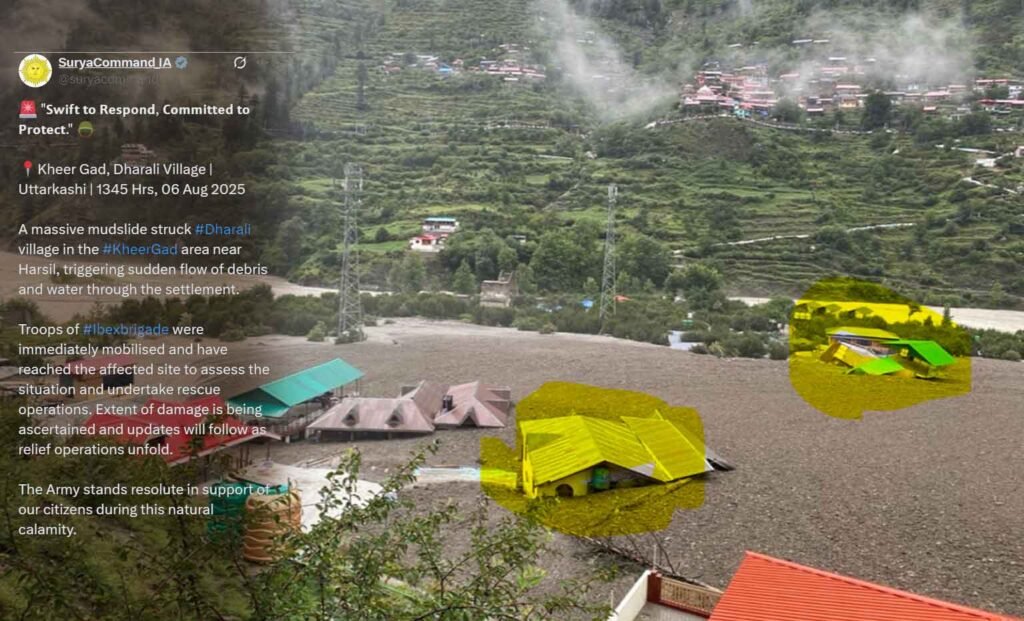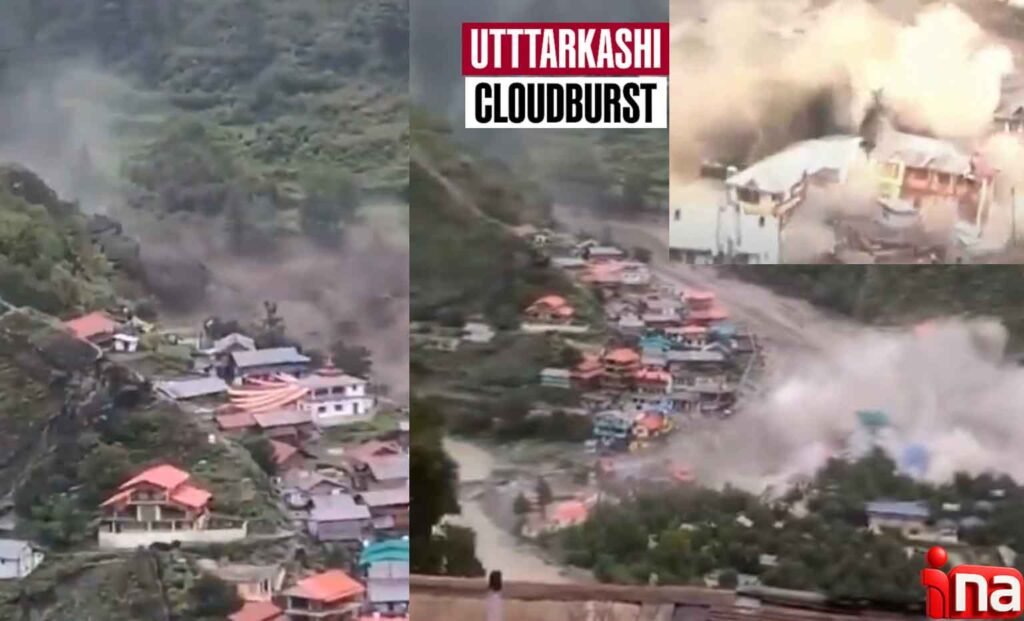Uttarkashi, Uttarakhand —INA
A sudden and severe cloudburst struck the high-altitude Dharali village in Uttarkashi district, triggering deadly flash floods and debris flows downstream along the Kheer Ganga river. As of today, authorities have confirmed at least four deaths, while many more remain missing, with some feared buried under the wreckage of homes and hotels.

What Happened
- The disaster began at around 1:45 p.m., when intense localized rain in the catchment of Kheer Ganga unleashed a torrent of water and mud, obliterating buildings along the route from Harsil to Dharali.
- Channels, homes, 20–25 hotels and homestays, and market areas were swept away, reducing the village to debris within moments.
- Eyewitnesses reported widespread panic: residents could be heard screaming and running for safety as walls and roads collapsed under the force of the flood.
Casualties & Damage
- Four people confirmed dead, and up to 50 others feared missing—many potentially buried beneath rubble.
- Lieutenant Rajesh Panwar, a local villager, estimated 10–12 people might be trapped. At least a dozen hotels and homestays were destroyed.
- Impact extended to livestock losses in nearby areas; for instance, 18 goats were reported swept away in Barkot’s Banala Patti region.
- The Char Dham pilgrimage route, which sees hundreds of thousands of visitors annually, is severely disrupted. Estimates suggest 400–500 pilgrims are stranded nearby.
Rescue & Relief Operations
| Agency | Role and Status |
|---|---|
| State Disaster Response Force (SDRF) | Deployed immediately from district teams for search, rescue, and first aid |
| National Disaster Response Force (NDRF) | Four battalions dispatched along with ITBP support in difficult terrain |
| Indo‑Tibetan Border Police (ITBP) | Rapid deployment into high-altitude areas |
| Indian Army – Ibex Brigade, Central Command | First on-site; rescued and evacuated 15–20 people to Harshil medical unit |
- Chief Minister Pushkar Singh Dhami confirmed relief efforts are being conducted “on a war footing,” with all disaster teams coordinating closely.
- Union Home Minister Amit Shah directed the federal deployment of NDRF and ITBP resources and assured survivors would receive full assistance.
- Prime Minister Narendra Modi extended condolences, stating “no stone is being left unturned” in rescue and relief provision.
Weather Forecast & Risks Ahead
- The India Meteorological Department (IMD) has issued a red alert for continuing heavy to very heavy rainfall in Uttarakhand until August 10.
- Flash floods, landslides, and further cloudburst incidents remain a serious immediate risk to rescue operations and stranded communities.
- Experts underscore a pattern: Himalayan regions are increasingly prone to extreme monsoon weather, linked to climate change and unplanned development.
Historical Context: Climate & Disaster Patterns
- Similar disasters have struck Uttarakhand in the past:
- 2012 flash floods saw 31 fatalities and dozens unaccounted for following a massive cloudburst and landslide.
- Earlier in 2025, a cloudburst at Silai Band killed two workers and left several missing, disrupting the Yamunotri pilgrimage route.
- These recurring disasters highlight persistent vulnerabilities in infrastructure planning, early warning systems, and terrain management.
On-the-Ground Realities
- With roads washed away and power lines down, rescue teams are navigating by foot, drone reconnaissance, post-disaster helicopters, and local knowledge.
- Helpline numbers in Uttarkashi—01374222126, 01374222722, 9456556431—offer immediate assistance or missing person reporting.
- Relief camps are being swiftly set up in safer nearby villages, while medical units treat dehydration, trauma, and injuries among evacuees.
Why This Disaster Matters
- Dharali’s destruction underscores how flash floods in Himalayan villages can escalate rapidly, leaving little time for evacuation.
- The original guiding principle of cloudburst management— “localised, high-intensity rain causing disproportionate downstream flooding”—rings true in Uttarakhand’s fragile geography.
- This incident serves as a renewed wake-up call on climate readiness and disaster resilience in mountain states.
Final Thoughts
The devastating cloudburst in Uttarkashi’s Dharali village has once again brought into focus the challenges of balancing economic livelihood, pilgrimage tourism, and natural hazard preparedness. As rescue and relief operations continue through the monsoon window, recovery efforts must be paired with adaptive infrastructure planning—particularly in flood-prone Himalayan corridors.


